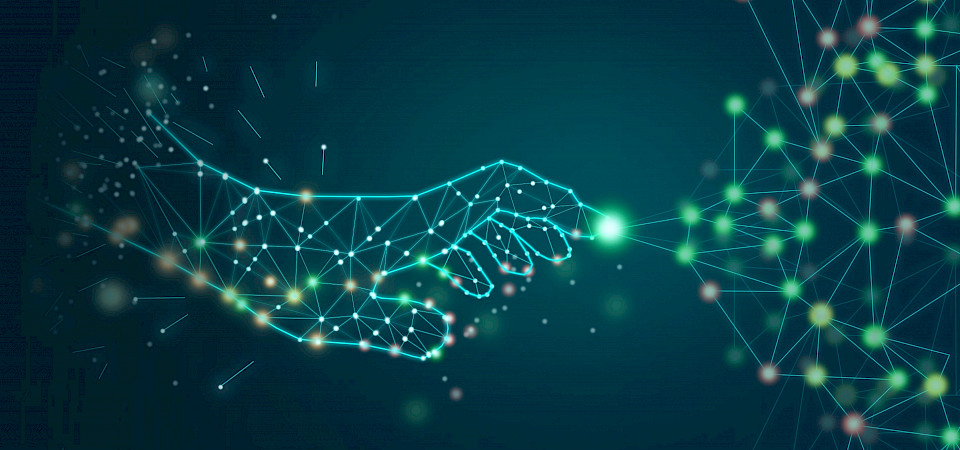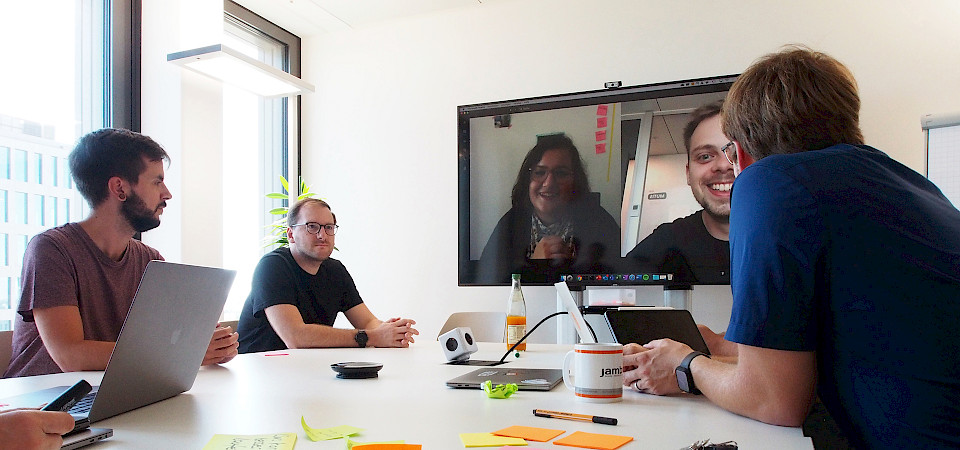Digital Twin
Tailor-made software solutions from jambit

Any object (e.g. car, machine, household item, workpiece) that exists in the real world can have a digital representation. It can usually represent some of the properties and states of the original. This representation is called a digital twin. Depending on how detailed you want or need to be, the representation can vary in complexity, or include different aspects. The bridge between the real and digital world only has to be crossed once – between the object and its twin. For example, a simulation can now run on a digital twin, which is usually much cheaper and easier than using the real object. In addition, you can make the digital twin communicate with other digital twins or systems over the Internet. This aspect is also realized much easier and often cheaper digitally than letting the object itself communicate directly.
This approach is used in all industries that want to digitize their products or production processes, or create digital value-added services for their products. For example, the digital twin is an essential building block for the Internet of Things (IoT) and can also be found in solutions of the VR / AR technologies. The development of a digital twin can add great value to the challenges that many of our customers have to face.
Why a digital twin? Faster, more flexible, less expensive
Companies that rely on digital twins put themselves in a position to add digital services or aspects to their physical products. But the time-to-market is much shorter, because for the digital twin you need to apply the development times for digital products, not those for physical products. In this context, especially the ability to react flexibly and quickly will determine the future viability of companies.
In addition to the product, the production process itself can also be lifted into the digital realm. A digital twin in combination with the corresponding data analysis (industrial analytics) can easily locate potential savings. In a second step, this offers the opportunity to increase quality or reduce waste. As a result, companies can optimize the production process and save costs. In practice, simulations on digital twins, for example, can be used to dynamically design production processes to ensure optimal capacity utilization. In combinations with shift schedules or the connected worker, even the human being can be considered as part of the production process. The optimal interaction of all aspects.
The described examples have an industrial context. The digital twin as a concept is certainly transferable to other areas such as banking and insurance.
Digital twin as solution approach in the industry
Companies with an evolved IT landscape often start with heterogeneous (eco) systems and struggle with increasing price pressure. In addition, especially in producing physical goods, the digital aspect of products is not the core of the producer's product portfolios.
The challenge for the path to the future is to initiate a transformation while at the same time maintaining established value chains, supplementing them, and creating new ones. In this context, the digital twin is a broad concept that must be adapted to the customer's needs, opportunities, and specifics. It does not matter whether the digital twin represents real things or abstract processes. The following example of physical production makes this clearer:
An archetypal problem for our customers: manual production process steps where humans close the gap between various IT systems. This is still practicable in reality, but usually costs time and requires a lot of implicit employee knowledge. Stringent reproduction in the digital twin makes it possible to work through possible legacy issues and systems. In addition, the mandatory transparency uncovers optimization opportunities and avoids unnecessary costs. This shows that the digital twin is not an end in itself, but can enable an improvement in the value chain – at the level of abstract processes or real things. The aforementioned problem often applies to digitization projects, and the digital twin is seen as a possible solution approach.
Another recurring problem is physical products whose USP is more and more shifting to the digital realm. In these cases, the product itself is no longer sufficient to secure the necessary lead over competitors. Other digital aspects are increasingly becoming decisive for purchasing. This applies to the B2B sector as well as to B2C. A digital twin offers a good basis for implementing value-added use cases that go beyond pure networking.
Digital twin projects with jambit: everything from one single provider

The implementation of a digital twin often includes many technological areas. jambit has broad knowledge and profound expertise across system boundaries. Certainly relevant for this is the profound back-end know-how in interaction with Big and Fast Data. In the area of architecture, cloud computing is our daily business and edge computing is becoming increasingly relevant, especially in the industrial environment. Thanks to many years of experience in the areas of infrastructure and operations, jambit can also easily cover this aspect. If the digital twin also extends to the areas of artificial intelligence and machine learning, our Competence Center AI/ML is always involved.
When developing digital twins, most important is often the interaction of these different areas. SInce our service is based on the principle "everything from one single provider", we offer our customers the advantage of being able to perfectly coordinate the areas for the optimal development of the digital twin.
Learn more about our service portfolio
In addition, jambit offers in-depth non-technical knowledge gained from many projects. How do you even start a digital twin project? What is possible and what is necessary? And in which time frame? We provide answers to these questions and advise our customers step by step. jambit provides tailor-made support, starting from the company's actual state.
Broad industry and domain knowledge help us in doing so. We know the actual state of our customers and their industries and their framework conditions. What pains and constraints they have and what challenges they typically face. In projects such as the component traceability for ams-OSRAM International GmbH, the production process was mapped and the path of the components was made traceable. In addition to the technical integration of various data sources and the heterogeneous ecosystem, the technical nature and the special features of the customer's processes were particularly challenging. In a trusting collaboration, we created back-end and front-end applications with a carefully considered UI/UX and accompanied the customer from the first design via an MVP to the go-live.
Looking for a competent service provider for your digital twin project?
Contact us now!
Maximilian Schenk is looking forward to your message.


